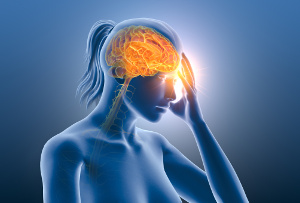How Q10 prevents and relieves migraines
 High-dosed supplementation with coenzyme Q10 is able to reduce the frequency, severity, and duration of migraine attacks, which is because the compound reduces levels of a brain peptide that causes pain and inflammation. This was shown in a groundbreaking study that is published in Nutritional Neuroscience. Pharmaceutical companies are now working around the clock to develop a patentable drug that is able to block this peptide, but migraine sufferers may just as well use Q10. It is already available without a prescription. Always choose a high-quality product with documented bioavailability to ensure that the Q10 molecules reach the energy-producing mitochondria of the cells. The reason why migraine sufferers may have an increased need for coenzyme Q10 is that they have mitochondrial defects.
High-dosed supplementation with coenzyme Q10 is able to reduce the frequency, severity, and duration of migraine attacks, which is because the compound reduces levels of a brain peptide that causes pain and inflammation. This was shown in a groundbreaking study that is published in Nutritional Neuroscience. Pharmaceutical companies are now working around the clock to develop a patentable drug that is able to block this peptide, but migraine sufferers may just as well use Q10. It is already available without a prescription. Always choose a high-quality product with documented bioavailability to ensure that the Q10 molecules reach the energy-producing mitochondria of the cells. The reason why migraine sufferers may have an increased need for coenzyme Q10 is that they have mitochondrial defects.
Recurrent migraine attacks can be detrimental for your quality of life and it is one of the diseases that accounts for the highest number of sick days. Migraine medicine does not help all patients and in many cases, there are side effects. It is therefore better if you can treat the underlying cause, which is often a lack of coenzyme Q10 combined with mitochondrial dysfunctions.
|
Q10 is both an energy provider and an important antioxidant
Q10 is an essential coenzyme that participates in the energy production inside all cells. At the same time, Q10 is a very important antioxidant that protects cells, mitochondria, and the cardiovascular system against oxidative stress caused by free radicals.
We humans produce most of the Q10 that our body needs, but the endogenous Q10 synthesis decreases with age. This can easily affect our health and vitality. Certain diseases such as migraine plus regular use of cholesterol-lowering drugs (statins) may also deplete our Q10 levels.
The brain requires enormous amounts of energy, which is why it also has an enormous need for Q10 to protect neurons and their mitochondria against oxidative stress. Oxidative stress is when there is an imbalance between free radicals and antioxidants .It should be noted that Q10 is one of the most potent antioxidants for protecting the mitochondria.
The many functions of mitochondria
Mitochondria burn calories and convert them into energy with help from Q10 and the oxygen we breathe. As part of this process, electrons are transmitted through a chain of enzymes in the so-called electron transport chain. Q10’s job is to receive and forward the electrons to ensure that the energy is eventually stored chemically in the molecule called ATP (adenosine triphosphate).
Mitochondria have many other essential functions, however, such as regulating cellular metabolism, calcium signaling, controlling the membrane potential (the electrical potential difference across the cell membrane), and apoptosis (also known as programmed cell death). Because the mitochondria have so many vital functions in the cellular metabolism, mitochondrial damage and the accompanying malfunctions can lead to a number of different diseases. One of them is migraine.
Migraine sufferers of all ages often lack Q10 and can benefit from taking a supplement
Studies show that around 30 percent of migraine patients have low Q10 levels in their blood. There also seems to be a link between migraines and inflammation. Q10 has anti-inflammatory properties, which is why a group of researchers decided to investigate whether Q10 supplements had the potential to relieve or cure migraine headaches.
Several studies have already shown that Q10 supplementation has a positive effect. An open study where the participants were given 150 mg of Q10 daily showed that 61% of the treated patients felt better. The number of days where they suffered from a migraine headache was reduced by 50%.
In another study, which was double-blinded and placebo-controlled, the participants were treated with high doses of Q10 (3 x 100 mg per day). Here, the scientists also observed fewer attacks and fewer days with migraine.
Even children suffering from migraine lack Q10, according to a study that is published in the science journal Headache. This study also revealed that three months of supplementation with Q10 increased serum levels of Q10 and significantly reduced the number of migraine attacks and their duration.
|
The Canadian Headache Society started recommending Q10 supplements to prevent and relieve migraine headaches as early as in 2015 |
Q10 lowers blood levels of two compounds that are linked to migraines and pain
A study of female migraine sufferers has demonstrated that Q10 can reduce pain. One group of women got 400 mg of Q10 daily, while the other group got matching placebo. After three months, the women in the Q10 group had significantly fewer migraine attacks compared with the women in the placebo group, suggesting that Q10 can prevent migraines. The few women in the Q10 group who got a migraine attack despite taking Q10 got over it faster and with fewer symptoms than the women in the placebo group. As seen, the study supports earlier studies. However, as something new, the scientists observed that Q10 has a pain-relieving effect, which is because Q10 lowers blood levels of two biochemical compounds that are linked to migraine. One is a brain peptide called CGRP (calcitonin gene-related peptide) that is involved in the transmission of pain impulses. It is produced by neurons. The other is a cytokine named TNF-alpha, which is a well-known marker of inflammation. In other words, Q10 relieves migraines by reducing levels of CGRP and inflammation. The study is published in Nutritional Neuroscience.
An earlier study has demonstrated that people suffering from occasional migraine attacks have elevated levels of CGRP in their blood, and individuals with chronic migraine have even higher CGRP levels.
How CGRP affects the brain
Pain more than any other single factor makes people take medicine, even though there are many things about the origin of pain that science does not understand. Still, migraine seems to involve two factors:
- An overstimulation of the brain caused by normally harmless stimuli
- An inflammatory response in different parts of the brain
CGRP is released when the brain neurons are stimulated. CGRP causes the blood vessels to dilate, including the blood vessels in the highly pain-sensitive outer membrane that covers the brain. When CGRP binds to specific receptors in the blood vessels, cascades of pain reactions are triggered and that is what causes the migraine.
If you inject CGRP it can trigger a migraine attack. That is how powerful it is.
Natural migraine relief with Q10
Other clinical studies have shown that if you block, prevent, or lower the production of CGRP, it may offer migraine relief within two hours, keep pain at bay for 24 hours, and prevent the sensitivity towards light and noise that comes with migraines. The pharmaceutical industry is currently working around the clock to find new, patented drugs that can block the production of CGRP in the body. However, high-dosed supplements of Q10 have already been shown to deliver this effect – without any side effects and with considerable health advantages.
As mentioned, migraine is often caused by inflammation and mitochondrial dysfunction, which increases the need for Q10. For that reason, supplementation with Q10 should be part of the treatment of this painful condition, simply because it is always better to treat the underlying cause than to deal with the symptoms, once they have occurred.
Choose pharmaceutical-grade Q10
The quality of any Q10 preparation determines how effective it is. Simply put, this is because humans have difficulty with absorbing Q10 in the digestive tract, unless the preparation is formulated in a way that allows each Q10 molecule to pass through the intestinal wall and enter the bloodstream. This requires using special oils and a unique heating technique.
Always choose pharmaceutical-grade Q10 where great demands are placed on the quality and content of the product. This is the only way to ensure that the body can absorb the active ingredient so it gets inside the mitochondria.
|
Q10, vitamin B2, and magnesium is a good combination
It is a good idea to combine Q10 therapy with vitamin B2, which is also important for mitochondria and their energy turnover. Magnesium also supports mitochondrial function, including calcium signaling. If uncontrolled, this process may cause cellular stress and inflammation. Large doses of magnesium (400-600 mg) may also relieve migraine by blocking the glutamate receptor NDMA, thereby preventing nerve cells from being flooded by calcium ions.
References:
Stephanie Carter. CoQ10 Targets the Cause of Migraine Headaches. Life Extension Magazine 2019
Dahri M et al. Oral Q10 supplementation in patients with migraine: Effects on clinical features and inflammatory markers. Nutr Neurosci. 2018
Malhotra R. Understanding migraine. Potential role of neurogenic inflammation. Ann Indian Acad Neurol 2016
Ramachandran R. Neurogenetic inflammation and its role in migraine. Semin Immunopathol 2018
Abdollahzad H et al. Effects of Coenzyme Q10 Supplementation on Inflammatory Cytokines (TNF-alpha, IL-6) and Oxidative Stress in Rheumatoid Arthritis Patients. A Randomized controlled Trial. Arc Med res. 2015
Hershey AD et al. Coenzyme Q10 deficiency and response to supplementation in pediatric and adolescent migraine. Headache. 2007
Rozen TD et al. Open label trial of coenzyme Q10 as a migraine preventive. Cephalalgia. 2002
Sandor PS et al. Efficacy of coenzyme Q10 in migraine prophylaxis: a randomized controlled trial. Neurology 2005
Pringsheim T et al. Canadian Headache Society guideline for migraine prophylaxis. Can J Neurol Sci 2012
Russo AF. Calcitonin gene-related peptide (CGRP): a new target for migraine. Annu rev Pharmacol Toxicol 2015
Guo S et al. Calcitonin gene-related peptide induced migraine attacks in patients with and without familial aggregation of migraine. Cephalalgia 2017
Mitchel L. Zoler. Moderately high dietary riboflavin linked to fewer migraines. Neurology 2019
Anna E. Kirkland et al. The Role of Magnesium in Neurological Disorders. Nutrients 2018
Mauskop A, Varughese J.: Why all migraine patients should be treated with magnesium. Journal of Neural Transmission 2012
A Peikert et al. Prophylaxis of Migraine with Oral Magnesium: Results from a Prospective, Multi-Center, Placebo-Controlled and Double-blind Study. Cephalalgia 1996
Pernille Lund. Q10 – fra helsekost til epokegørende medicin. Ny Videnskab 2014



